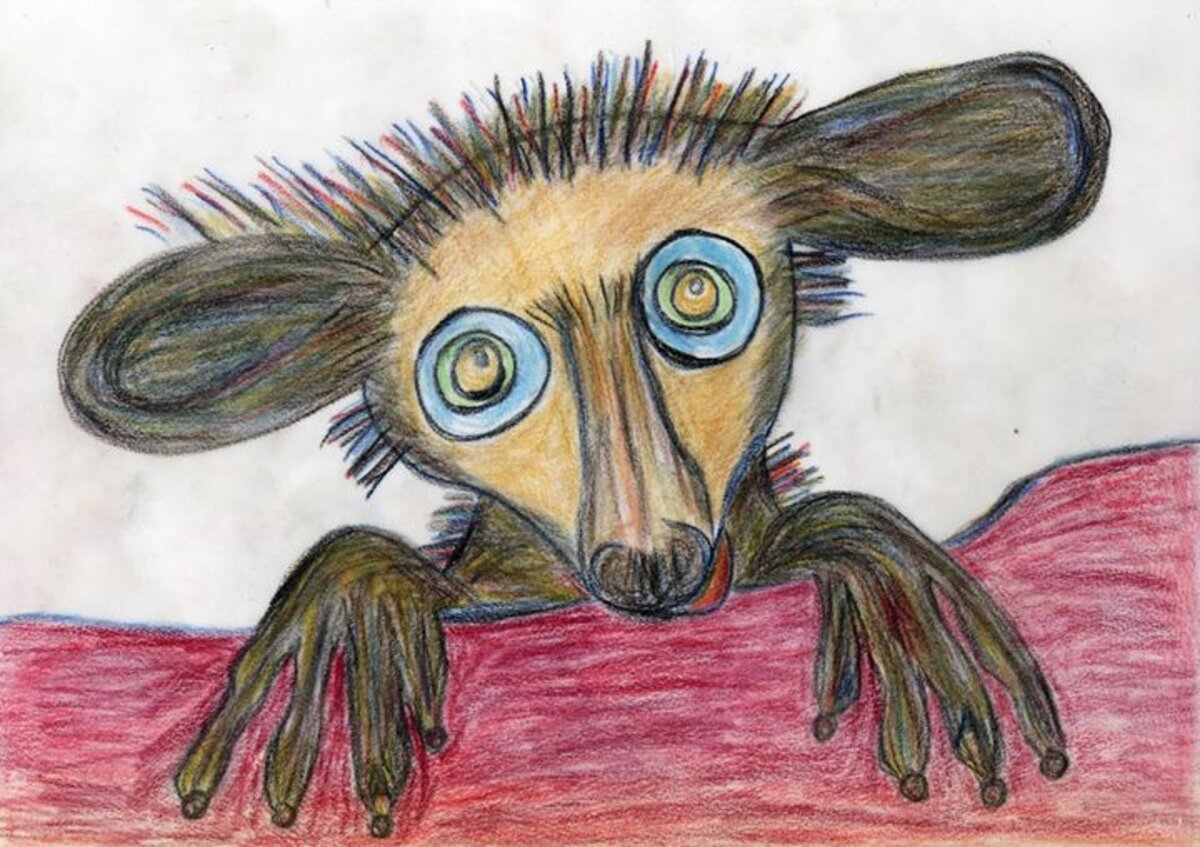
Agrandissement : Illustration 1

"THE AYE"
For
ARCHIBISHOP DESMOND TUTU 85 BIRTHDAY
&
PEACE CONFERENCE, CAPE TOWN
MONSEIGNEUR
ARCHBISHOP DESMOND TUTU
"Just call me Arch"--Desmond Tutu
Monseiugneur Desmond Tutu was born in the state of Transvaal at Klerksdorp in South African. He attended Johannesburg Bantu High School. He dreamt of being a physician but his parents could not afford to send him to medical school. In 1954 South African government did not extend the rights of citizenship to blacks and The National Party had risen to power on the promise of instituting a system of apartheid. South Africans were legally assigned to official racial groups; each race restricted to a separate living area. Black people couldn't vote and were only represented in the local governments by tribal homeland representatives. Interracial marriage was forbidden, blacks were legally barred from certain jobs, and prohibited from forming labor unions. They needed passports for travel within the country. Critics of the system could be banned from speaking in public and subjected to house arrest.
Desmond Tutu refused to cooperate when the government ordained an inferior system of education for black students. He subsequently was banned from working as a teacher and on the advice of his bishop he began to study for the Anglican priesthood. In 1960 Tutu was ordained as a priest in the Anglican Church.
Meanwhile the South African government began a program of forced relocation of Black Africans and Asians from newly designated white areas. Millions were deported to the homelands, then permitted to return as guest workers. From 1962 to 1966 Desmond Tutu lived in England, where he earned a master's degree in theology. He taught theology in South Africa for five years, then returned to England to serve as an assistant director of the World Council of Churches in London. In 1975 he was the first Black African to serve as Dean of St. Mary's Cathedral in Johannesburg. From 1976 to 1978 he was Bishop of Lesotho. In 1978 he became the first Black General Secretary of the South African Council of Churches.
As a Bishop Tutu used the national platform to denounce the apartheid system as "evil and unchristian," calling for equal rights for all South Africans and a system of common education. He demanded the repeal of the oppressive passport laws as well as an end to forced relocation, encouraged nonviolent resistance to the apartheid regime, and advocated an economic boycott of the country. Though the government revoked his passport to prevent him from traveling and speaking abroad his case soon drew the attention of the world and the international public raised an outcry.
Tutu rose to worldwide fame during the 1980s as an opponent of Apartheid. In 1984, Desmond Tutu was awarded the Nobel Prize for Peace, "not only as a gesture of support to him and to the South African Council of Churches of which he is leader, but also to all individuals and groups in South Africa who, with their concern for human dignity, fraternity and democracy, incite the admiration of the world." In 1986 he was awarded with the Albert Schwitzer Prize for Humanitarianism . In 1986 he was elected Archbishop of Cape Town, the first Black African to serve in this position. It placed him at the head of the Anglican Church in South Africa and made him defacto Archbishop of Canterbury, spiritual leader of the Church of England. In 1987 Tutu was awarded with the Pacem in Terris Award International economic pressure and internal dissent forced the South African government to reform and in 1990, Nelson Mandela of the African National Congress was released after almost 27 years imprisoned on Robben Island. In 1991 the South African government at last began the repeal of racially discriminatory laws.
In 1994 after the country's first multi-racial elections, President Nelson Mandela appointed Archbishop Tutu to chair the Truth and Reconciliation Commission, investigating the human rights violations of the previous 34 years. Tutu counseled forgiveness and cooperation, rather than revenge for past injustice. In 1996 he retired as Archbishop of Cape Town and was named Archbishop Emeritus. Then he served for two years as Visiting Professor of Theology at Emory University in Atlanta, Georgia. Published collections of his speeches, sermons and other writings include Crying in the Wilderness, Hope and Suffering, and The Rainbow People of God.
In 1999 he was awarded with the Sydney Peace Prize. In 2007, Desmond Tutu joined former South African President Mandela, former President Jimmy Carter, retired U.N Secretary General Kofi Annan, and former Irish President Mary Robinson to form The Elders, a private initiative mobilizing the experience of senior world leaders outside of the conventional diplomatic process. Tutu was named chair of the group. Carter and Tutu have traveled together to Darfur, Gaza and Cyprus in an effort to resolve long-standing conflicts. The same year he was award with the Ghandi Peace Prize. Desmond Tutu's historic accomplishments and his continuing efforts to promote peace in the world were recognized by the United States in 2009 when Barack Obama gave him the Presidential Medal of Freedom. In 1955 Desmond Tutu married Nomalizo Leah Shenxane, they have four children and have been happily married for six decades. His house on Vilakazi Street in Soweto, Johannesburg, is registered as part of Johannesburg's historical heritage.
In 1986 Jazz wizard Miles Davis dedicated his album Tutu to Desmond Tutu. He contacted Virgin Radio on 15 October 2007 in the "Who's Calling Christian" phone-in where famous people call in order to raise a substantial amount of money for charity.
Tutu has donated some of his own cells to the ongoing effort to research the diversity of the human genome. In 2009 Tutu joined the project "Soldiers of Peace," a movie against all wars and for global peace. He is one of the patrons of The Forgiveness Project and delivered the charity's inaugural annual lecture in 2010.
In 2014 the Mayor of Cape Town Patricia De Lille allocated the Granary Building to Mama Leah and Tata Tutu to build a museum and preserve his legacy.
Tutu's followers know him as a great man who, since the demise of apartheid, has been active in the defence of human rights and uses his high profile to campaign for the oppressed. He has campaigned to fight HIV/AIDS, Poverty, Racism, Sexism, Homophobia and Transphobia. Tutu supports assisted dying and believes in assisted death.
On October 2nd Monnseigneur Tutu launched The Book of Joy with his holiness Dalai Lama, a project to spread joy and understanding among human begins over our planet. For six years he's been the chair of the Annual Peace Conference in Cape Town.
"The Aye" is adapted from Ana Isabel Ordonez’s "The Extraordinary Love Story of Aye Aye and Fedor."
The choreography comes together in a sparkling fusion of music, dance and narration to be performed on two special nights of this 2016 year by the Jazz Dance Theatre with Sifiso Kweyama as choreographer. The shows are to honour Nobel Peace Laureate Archbishop Emeritus Desmond Tutu, in celebration of his 85th birthday, and with the opening choreography for the annual Peace Conference in Cape Town.
The dance theatre extravaganza depicts a beautiful and magical love story between two threatened animals, a lemur Aye Aye and a white lion Fedor--each of whom define the term "opposites attract" in a fantastic universe called the Musical Forest.
The narrative is enhanced and fleshed-out via weighty, emotive roles for the dancers."The Aye" From “The Extraordinary Love Story of Aye Aye and Fedor". This is the world premiere of the show. The book has been translated into four languages and has graced the shelves of the Beijing and Frankfurt book fairs. The dance theatre version will be seen for the first time by South African audiences. The music was composed by Dutch pianist Michiel Braam. In performance it includes amusing narration by singer Dean Bowman. The definitive recorded version is performed by eBraam which includes drummer Dirk-Peter Kölsch, guitarists Pieter Douma and Jorg Lehnardt, and harpist Ulrike von Meyer.
The Aye is quite simply a magical show, featuring a fantastic set, a superb jazz-rock score, inspired choreography and mischievous masks hand made in South Africa by La Carla Masks.
The Aye is a brilliant music and spectacular dance extravaganza that is not to be missed.
The Story/Ballet
Midnight. Not a sound in the jungle. Suddenly an explosion of music and lights reveals a larger-than-life wildlife experience. Lights tear across the bush landscape catching the darting image of an animal reaching a unique place, the Musical Forest. It is a special moment when all animals in the story are reunited, finally free. They have escaped from a zoo with the courageous help of a lemur, Aye Aye, inspired by her love for Fedor who bravely reunites all animals who are now allowed to celebrate who they are.
While Aye Aye was free to run wild and enjoy the forest, Fedor was stuck in a zoo. The two meet while he is in captivity. They strike up a friendship that helps them both make some important discoveries and launches them on a journey to places they never thought they’d go. Although the animals at the zoo had a difficult time in captivity, the story has a happy ending, thanks to the courage and quick thinking of Aye Aye and Fedor.
In this first scene they and the other animals of the Musical Forest emerge, dancing to express their unique abilities and special traits. All the animals begin to reveal themselves and their wisdom. It is the contemplation of this gift that keeps these animals deep in thought.
ANA ISABEL ORDONEZ, Producer, Writer, Poet and Illustrator
Author and illustrator Dr. Ana Isabel Ordonez is a renaissance woman who shares her love of the natural world with young readers. An educator, scientist and lecturer, Ordonez has travelled the world, enjoyed varied cultural experiences and met interesting people and animals along the way. Thanks to her extensive education in France and the United Kingdom (with Masters and Ph.D.'s in genetics, forestry and animal biology) she has a strong base of knowledge when it comes to various animal species, helping make her books and poetry educational, inspirational and entertaining. Her early poetry was profoundly influenced by the French symbolists, especially Verlaine and Parnassianists like Théophile Gautier.
Ordonez’s goal when writing "The Extraordinary Love Story of Aye Aye and Fedor" was to show both the diversity and the similarities between members of the animal kingdom. She also wanted to communicate the idea that like humans, animals want to be happy, respected, safe and free. Aye Aye and Fedor’s journey is a great example of friendship and cooperation between friends who on the surface seem to be very different from one another, but who have similar goals and a desire to share their lives together.
With"The Aye" ballet series the poet wants to bring happiness and awareness to others, to touch the inner being of people she does not know. Ordonez also wants to touch young dancers with a unique love story filled with wisdom and rhythm, surrounding a loving friendship that exists between threatened animals. As both lemurs and white lions are rare and threatened species, so this show speaks to the important issue of appreciating and protecting endangered animals.
The whimsical illustrations in the book and the CD album will appeal to children because they look much like the colourful, bright, humorous drawings that many children enjoy making themselves. As an artist, Ordonez puts an emphasis on playfulness as well as on capturing the nature and spirit of characters. The overall effect is a show that both kids and adults will love. A very sensitive being, Ana Isabel is passionate about the importance of education, music, poetry and art. Her Ruby Flower record label has become an important asset for the arts and music community.
SIFISO KWEYAMA, Director and Choreographer
Born and bred in KwaZulu Natal Mr. Kweyama has established himself as one of the well-respected teachers and choreographers in the country. Sifiso started training in 1989 at Phenduka Dance Theatre in Durban. In 1993 Joined the Jazzart Dance Theatre in Cape Town by Alfred Hinkel where he was trained in Contemporary African Dance and went on to perform in numerous Jazzart’s award winning productions.
He has worked with higher institutions such as the Tshwane University of Technology, University of Pretoria as an African dance and contemporary dance lecture respectively. His contribution to the arts has seen Kweyama being invited by the two US institutions to lecture on dance and to choreograph for the University of South Florida and University of Southern California in America. Because of his knowledge in African dance Sifiso has been invited to assess dance by University of Cape Town in numerous times, Zululand University (Ongoye), National School of the Arts in Braamfontein and East Rand in Johannesburg
His dance career has seen him travel to countries such as Morocco, America, Germany, Abidjan, Angola, China just to mention a few. He has choreographed numerous works with various companies in the country and abroad with companies such as Moving into Dance, Ballet Theatre Afrikan, Flatfoot Dance Company, Jazzart Dance Theatre, First Physical Theatre, Remix Dance Company, Repertory Dance Company (USA) just to name a few.
He is currently the Artistic Director of Jazzart Dance Theatre.
The 43 year-old Jazzart Dance Theatre is acknowledged as South Africa’s leading contemporary dance theatre company that has, and continues, to exert a powerful influence on the development of dance in South Africa. The company has over the years garnered many awards for innovative choreography and the consistent development of extraordinary performers.
The Jazzart methodology ensures that strong technique is matched with a uniquely South African dance philosophy that is rooted in the diversity of the culture and traditions of our country. Its prodigious creative and critical output allows it to use dance as a transformative tool and to fully interrogate social awareness and cultural inclusiveness – thus embodying the transformative principles and values of South Africa’s Bill of Rights.
Company Dancers:
Adam Malebo
Tracey September
Jazzart Second year Trainees:
Abdul-Aaghier Isaacs
Amber Jodie Andrews
Darion Adams
Gabriella Dirkse
Ilze Williams
Keenun Wales
Luyanda Mdingi
Lynette du Plessis
Mandisi Ngcwayi
Paxton-Alice Simons
Siphosethu Gojo
Tanzley Jooste
Thandiwe Mqokeli
Vuyolwethu Nompetsheni
Michiel Braam is a Dutch pianist and educator, Director of the Jazz Pop Music and Dance Department in Niemejen, Netherlands. An absolute maverick on the piano and in his compositions, he's frequently seen in jazz festivals and jazz clubs the world round. In 1988, Braam was honoured with the Podium prize and in 1997 he received the Netherlands' most important jazz prize, the VPRO/Boy Edgar Award.
The Aye album features the group eBraam performing Braam's own jazz-rock compositions written specially for the ballet: "Introduction," "Aye Aye At Work." "Small Meets Big," "Prison vs Dreamy Freedom," "Restful Peaceful," "Bad Weather," "Enclosure To Enclosure," "Escape," "Happy March," and "Love". Braam manages to inject his infectious skill and enthusiasm into the sequences to make every track fresh and cheerful. Each one is given a nice tempo treatment in a breezy ride from start to finish. Bowman adds his share of the soothsayer's touch to the whole endeavour and his work is surely a highlight of it all.
"The music was written by Dutch pianist-composer Michiel Braam and his eBraam band with some beautiful guitar work by guests Pieter Douma and Jorg Lehnardt. It is an eclectic blend of fusion jazz with memorable themes and a wide variety of grooves and moods to fit Ms. Ordonez's story of love and liberation. Dean Bowman's narrative captures the essence of the story nicely and ultimately the ballet will send the whole thing further into the story zone that the book gives us so amusingly and deeply.
Children of all ages will take to this, whether they have read the first book or not (though they should, ideally while listening to the CD). It holds its own with brilliance and a total experiential vibe.
Ana Isabel Ordonez carries the day!"
Together with Frans Vermeerssen he co-leads the sextet All Ears (with Herb Robertson, Frank Gratkowski, Wilbert de Joode and Michael Vatcher). He has worked also with musicians like George Lewis, Benjamin Herman, Han Bennink, Conny and Hannes Bauer and Steve Argüelles. The orchestra Bik Bent Braam was considered to be one of the main bigger orchestras in the field of improvisation-music and performed worldwide, as does the trio BraamDeJoodeVatcher still does.
In 2007 Braam composed Nopera, a sort of music theatre piece in which the written parts could be performed at random and contained lots of room for improvisation. The libretto was written in the Nothingyettish language. In 2012 Bik Bent Braam disbanded and a septet named Flex Bent Braam took its place. In 2013 the first program of that band, "Lucebert," was presented on stage and followed up with an album.
In 2015 eBraam recorded "The Extraordinary Love Story of Aye Aye and Fedor", with singer Dean Bowman as narrator, after Ana Isabel Ordonez's children's book, in a bigger project that involves also dance and fine art.
Dean Bowman is a singer known and praised worldwide for his angelic voice. He began singing in church and has appeared on many releases and on stage, working in both gospel and jazz styles. The New York native regularly performs all around the world. Ana Isabel's tale and ballet captures the veteran vocalist Bowman in an intimate performance that showcases his smooth, honey voice and winning delivery. His narration of Ordonez's love tale/poetry never sounds phony or forced and the tale itself exemplifies directly such an authenticity.
Carla Engelbrecht is a South African female, born in Johannesburg and raised in Durban. She tells us, "As a child I have always been exposed to art and creating beautiful environments. Her father dabbled in oil painting and her mother always encouraged her to experiment with arts and crafts. She had a very successful Floral Art School in Durban and did a lot of flower arrangements for functions, weddings and events as well as gave courses where she also organized job placements for students at the completion of the course. Carla always helped out and all through her school years learned the trade of floral art. Understandably, this has helped her tremendously with the masks.



